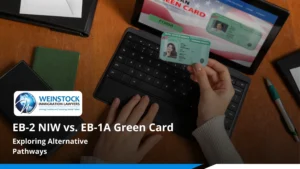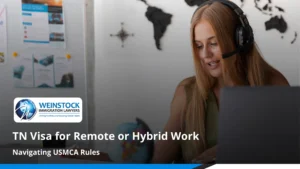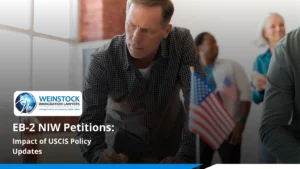Lawsuit Filed on the New H-1B Wage Rule
On October 8, 2020, the Trump Administration abruptly revamped the H-1B wage rule to dramatically change the program and sharply increase the required wages for temporary positions and others seeking employment-based green card sponsorship. The changes are aimed at discouraging U.S. employers from hiring and continuing to employ foreign workers. The minimum wage paid to H-1B workers from the occupational starting level to the median wage is the minimum, even for recent school graduates with no experience. This new rule did not follow regulations and the law about H-1B’s, so the court orders will likely repeal it.
A lawsuit has been filed against the new Department of Labor (DOL) H-1B wage rule, seeking a preliminary and permanent injunction. Many analysts, such as the National Foundation for American Policy and economic researchers, believe that the new H-1B wage rule acts as a deterrent to H-1B employers by significantly raising the minimum wage required to employ foreign workers. The analysts also explain why the H-1B new salary is more harmful than beneficial to the U.S. economy. This rule will also hurt international students who seek employment in the United States post-graduation.
The U.S. Chamber of Commerce filed the lawsuit, and other players have asked for the two H1B visa new rules to be set aside, saying they “were unlawfully issued without notice and comment and are arbitrary, capricious, or otherwise not in accordance with law”.
This lawsuit is not the first lawsuit against the administration, but the third. This third lawsuit has been filed by the U.S. Chamber of Commerce and other players, such as the National Association of Manufacturers, the Bay Area Council, and universities like Cornell University.
The plaintiffs also wanted the court to block the implementation of these rules by the DHS and DOL till the litigation was complete.
The lawsuit could help Indian I.T. and tech firms, which have a significant concentration of H-1B employees, and the substantial increase would bite into their margins.
At a time when employers need predictability and flexibility, the changes sow confusion and vexation, impacting not only new workers but also existing personnel. Whether the new rules go into effect as planned remains to be seen. Federal court litigation may delay or prevent the changes and restore the status quo. Businesses and associations have filed suit, challenging the wage changes, and H-1B rule changes as arbitrary and capricious.
When Are the Changes Effective? Both rules are “Interim Final Rules” that take effect without the typical notice and comment period.- Wage Increase by U.S. Department of Labor (DOL): “Strengthening Wage Protections for the Temporary and Permanent Employment of Certain Aliens in the United States,” (DOL Wage Rule) became effective immediately, without prior notice, on the date of publication, October 8, 2020.
- H-1B Revision by U.S. Citizenship & Immigration Services under the Department of Homeland Security (DHS): “Strengthening the H–1B Nonimmigrant Visa Classification Program,” (DHS H-1B Revised Rule) takes effect on December 7, 2020, but will not apply to H 1B petitions filed and pending before that date.
| Level | Wage Before Oct. 8, 2020 | Wage Effective Oct. 8, 2020 | Increase |
| 1 | $92,102 | $139,880 | 51.87% |
| 2 | $113,110 | $167,918 | 48.46% |
| 3 | $134,097 | $195,938 | 46.11% |
| 4 | $155,105 | $223,974 | 44.40% |
- LCAs filed on October 8, the categories of H-1B, H-1B1 (Chile and Singapore), and E-3 (Australia) are subject to the DOL Wage Rule. Impact: This includes LCAs for new H-1B petitions, including H-1B cap cases, H-1B transfer or change of employer, and H-1B extensions.
- PERM prevailing wage requests processed after October 8, 2020, will have increased wages applied. Impact: Employers should review pending and future prevalent wage requests to assess the effect of the higher required wages that DOL might assign.
- LCAs are valid for up to three years. Wages on approved LCAs will not change.
- The DOL Wage Rule will not impact pending H-1B petitions or those where U.S. Citizenship and Immigration Services (USCIS) issued a request for additional evidence (RFE).
- The DOL Wage Rule does not permit re-adjudication by a consulate during visa processing.
- For a PERM application underway, if the prevailing wage determination has already been issued, the wage will not change.
- The DOL Wage Rule will not impact an I-140 Immigrant Petition that is based on a PERM prevailing wage determination already issued.
- Change to the definition of “specialty occupation” requires that the employee’s degree be “directly related” to the occupation: This is a significant change that is likely to create more uncertainty about which occupations will qualify for H-1B status. Impact: If employers accept alternative degrees for a particular position, “each of those qualifying degrees must be directly related to the proffered position.” For example, for jobs in data analytics, information technology, machine learning, or artificial intelligence, accepting a Computer Science or Electrical Engineering degree without explaining how each degree is directly related to the job could result in denial under the DHS H-1B Revised Rule.
- Removal of what is “normal,” “common,” and “usual”: Before the change, an H-1B petition was approvable for jobs where a bachelor’s degree is “normally” required or “common to the industry,” or where the knowledge needed for the position is “usually associated” with at least a bachelor’s degree or equivalent in a specialty field. The DHS H-1B Revised Rule eliminates the terms “normally,” “common,” and “usually” from the criteria. Employers will now need to prove that a bachelor’s degree in a specific specialty is always the minimum requirement. Impact: This may create a nearly impossible task and stifle ingenuity for start-ups, small companies, nonprofits, and innovative employers with novel positions and job titles.
- Adding a requirement for evidence of sufficient “actual work available” as of the requested start date: The DHS H-1B Revised Rule requires that an employer must “have a bona fide, the non-speculative job offer.” Employing an H-1B worker for a job to meet “possible workforce needs arising from potential business expansions or the expectation of potential new customers or contract” would result in denial. Impact: The level of specificity that USCIS may require is unclear. The economic viability of the employer may be required to prove the job is not speculative.
- Adding factors on whether there is an “employer-employee relationship”: USCIS requires additional evidence to determine, based on the “totality of the circumstances,” whether a valid employment relationship exists between the beneficiary and petitioner:
- (i) Whether the petitioner supervises the beneficiary and, if so, where such supervision takes place;
- (ii) Where the supervision is not at the petitioner’s worksite, how the petitioner maintains such supervision;
- (iii) Whether the petitioner has the right to control the work of the beneficiary on a day-to-day basis and to assign projects;
- (iv) Whether the petitioner provides the tools or instrumentalities needed for the beneficiary to perform the duties of employment;
- (v) Whether the petitioner hires, pays, and has the ability to fire the beneficiary;
- (vi) Whether the petitioner evaluates the work product of the beneficiary;
- (vii) Whether the petitioner claims the beneficiary as an employee for tax purposes;
- (viii) Whether the petitioner provides the beneficiary any type of employee benefits;
- (ix) Whether the beneficiary uses proprietary information of the petitioner in order to perform the duties of employment.
- (x) Whether the beneficiary produces an end product that is directly linked to the petitioner’s line of business; and
- (xi) Whether the petitioner has the ability to control the manner and means in which the work product of the beneficiary is accomplished.
- Adding “employer-employee relationship” factors where the H-1B beneficiary possesses an ownership interest in the petitioning organization: To assess whether an “owner” is an “employee” that the petitioner has a right to control, USCIS may require evidence such as the following:
- (i) Whether the petitioning entity can hire or fire the beneficiary or set the rules and parameters of the beneficiary’s work;
- (ii) Whether and, if so, to what extent the petitioner supervises the beneficiary’s work;
- (iii) Whether the beneficiary reports to someone higher in the petitioning entity;
- (iv) Whether and, if so, to what extent the beneficiary can influence the petitioning entity;
- (v) Whether the parties intended that the beneficiary be an employee, as expressed in written agreements or contracts; and
- (vi) Whether the beneficiary shares in the profits, losses, and liabilities of the organization or entity.
- Third-party placement, limiting the validity period for H-1Bs to a maximum of one year: Under the statute, all H-1Bs may be issued up to three years. Under the DHS H-1B Revised Rule, petitions for beneficiaries who will work at third-party worksites will be limited to one year. Impact: Given lengthy processing times and the frequency of Requests for Additional Evidence (RFEs), employers may need to file extensions every six months.
- Adding inspection and compliance review provisions, including pre-approval inspection, at USCIS discretion: The incidence of H-1B site visits has decreased since the coronavirus (COVID-19) pandemic began in March 2020; USCIS appears to have resumed such visas in the past couple of months. Impact: Inspections may occur at any worksite, including a remote or home office location. Employers of H-1B nonimmigrants should be aware of the possibility of such H-1B site visits. They should take all appropriate actions to prepare for such visits, including developing a site visit protocol.
Related posts

Exploring Alternative Pathways: EB-2 NIW vs. EB-1A Green Card
Summary Two of the most sought-after green card options for highly qualified professionals are: EB-2 National Interest Waiver (NIW) EB-1A Extraordinary Ability visa Both allow

TN Visa for Remote or Hybrid Work: Navigating USMCA Rules
Summary If you’re a Canadian or Mexican entrepreneur living in the U.S. or planning to launch a business here, you may be wondering: Can I

Impact of USCIS Policy Updates on EB-2 NIW Petitions: What You Need to Know
Summary The EB-2 National Interest Waiver (NIW) offers a pathway to U.S. permanent residency without employer sponsorship, ideal for professionals and skilled workers. Recent USCIS
